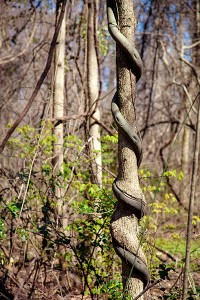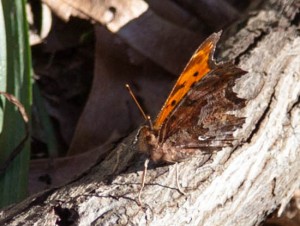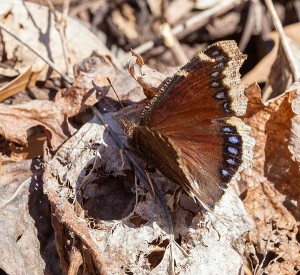Butterfly Wings in Spring
 Last week I was walking along the Old Forest trail when an unusual tree caught my eye. If you walk the trails frequently, you’ve probably noticed it: it’s been completely enveloped in rattan vine, and the tree bark has squeezed up over the surface of the vines. I could indelicately term it the “muffin top tree.” Anyway, I was taking a photo of the tree when I heard a little rustle at my feet. I had just enough time to look down and see a mourning cloak butterfly–the first butterfly I’ve seen in 2013–before it lifted off from the leaves and flew away from the trail. It was so quiet in the woods that I could hear the beating of its wings.
Last week I was walking along the Old Forest trail when an unusual tree caught my eye. If you walk the trails frequently, you’ve probably noticed it: it’s been completely enveloped in rattan vine, and the tree bark has squeezed up over the surface of the vines. I could indelicately term it the “muffin top tree.” Anyway, I was taking a photo of the tree when I heard a little rustle at my feet. I had just enough time to look down and see a mourning cloak butterfly–the first butterfly I’ve seen in 2013–before it lifted off from the leaves and flew away from the trail. It was so quiet in the woods that I could hear the beating of its wings.
In my experience chasing down butterflies, dragonflies, and their fellow photogenic insects, once you find a good spot it’s worth your while to return to it. So I’ve paid a couple visits to this location this week, and each time I’ve been rewarded.
On Tuesday, I immediately spotted two mourning cloaks chasing after each other along the trail. (Mourning cloaks are some of the longest-lived butterflies; they can live to about ten months, and some adults overwinter in the loose bark of trees. So the ones we’re seeing now are probably holdovers from last year who have come out in the springtime to mate.) Mourning cloaks are dark brown with iridescent blue spots, so I was surprised to see a flash of orange out of the corner of my eye.
 To the left of the trail was a red admiral resting on some leaves. (My photo was far away and fuzzy, so I won’t share it, but you can see one in this post.) Then to the right of the trail was an eastern comma. One of a couple of butterflies named after punctuation (making them beloved of English majors-turned-science-nerds such as myself), the comma is named for a small white marking on the lower part of its wing. Its cousin the question mark has a similar marking, just with (you guessed it) a little white dot on one end.
To the left of the trail was a red admiral resting on some leaves. (My photo was far away and fuzzy, so I won’t share it, but you can see one in this post.) Then to the right of the trail was an eastern comma. One of a couple of butterflies named after punctuation (making them beloved of English majors-turned-science-nerds such as myself), the comma is named for a small white marking on the lower part of its wing. Its cousin the question mark has a similar marking, just with (you guessed it) a little white dot on one end.
On Wednesday, the orange butterflies were nowhere to be found, but the mourning cloaks were roaming about. Mostly they were perched high in trees, so I assumed I wasn’t going to get a good close-up photo. I decided to circle the trail and check out wildflowers for a while, coming back to this spot on my way out of the forest. As I walked back through, I practically tripped over one that was resting on a log. It immediately flew away, but it circled right back. It rested there for several minutes as I gradually got closer and closer until I was only about a foot away. A little while later, I was watching it fly around while shading my eyes, and it actually came to perch on my hand. (So…we’re friends now?)
 So much coziness is not the norm, so my approach when photographing skittish insects is always to shoot first from wherever I’m standing when I see them. The photos probably won’t be usable for display purposes, but if that’s all I get, then I can generally enlarge them enough to make an identification. Then I move in closer by degrees, or just wait around for a while until they fly closer to where I’m standing. One thing I always have to remember is to mind my shadow. Insects are typically much more active on sunny days, and if my shadow crosses where the insect is sitting as I approach it, it’ll sense danger and fly away. (Minding their shadows is good too–sometimes I’m looking down and I see their shadows flying by before I see the actual butterflies.)
So much coziness is not the norm, so my approach when photographing skittish insects is always to shoot first from wherever I’m standing when I see them. The photos probably won’t be usable for display purposes, but if that’s all I get, then I can generally enlarge them enough to make an identification. Then I move in closer by degrees, or just wait around for a while until they fly closer to where I’m standing. One thing I always have to remember is to mind my shadow. Insects are typically much more active on sunny days, and if my shadow crosses where the insect is sitting as I approach it, it’ll sense danger and fly away. (Minding their shadows is good too–sometimes I’m looking down and I see their shadows flying by before I see the actual butterflies.)
Sometimes, like with this mourning cloak, I’ll encounter an insect that is willing to sit still even though I’m very much in its personal space. After I’ve taken enough good close-ups, I like to try to back up and compose something a little more artistic if possible. I like this final shot because it looks like the butterfly is resting in the woods contemplating nature–which is just what I like to do as often as possible.
Want to see if you can spot these butterflies? Take the Old Forest trail to marker #9 (where the trail crosses another). Instead of bearing left to marker #10, go straight. You’ll see the rattan-wrapped tree on your left after just a few feet. Stand there and watch for the fluttering of wings!




